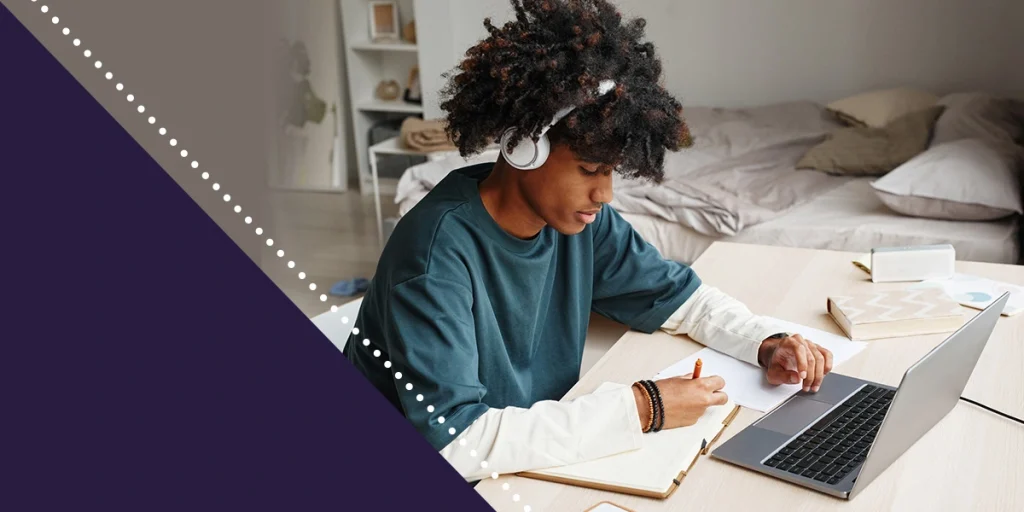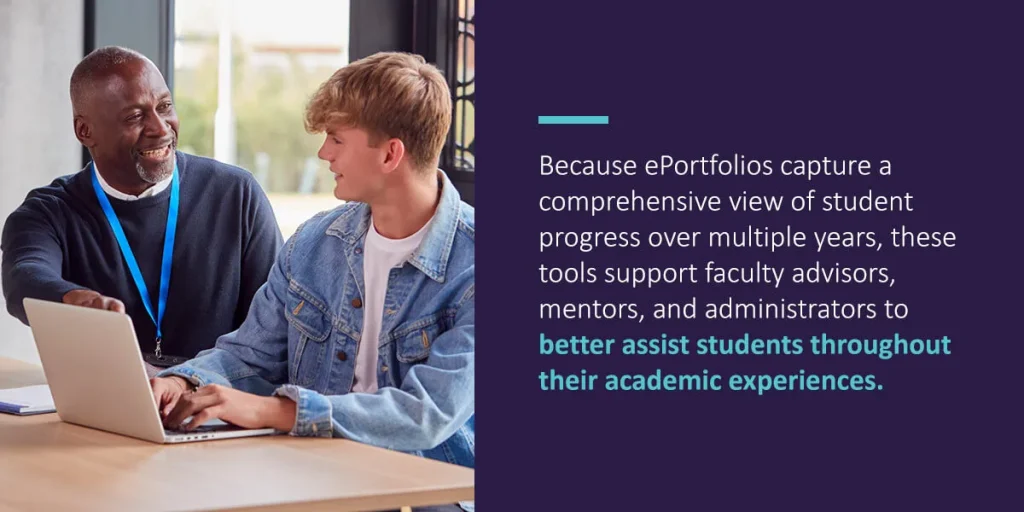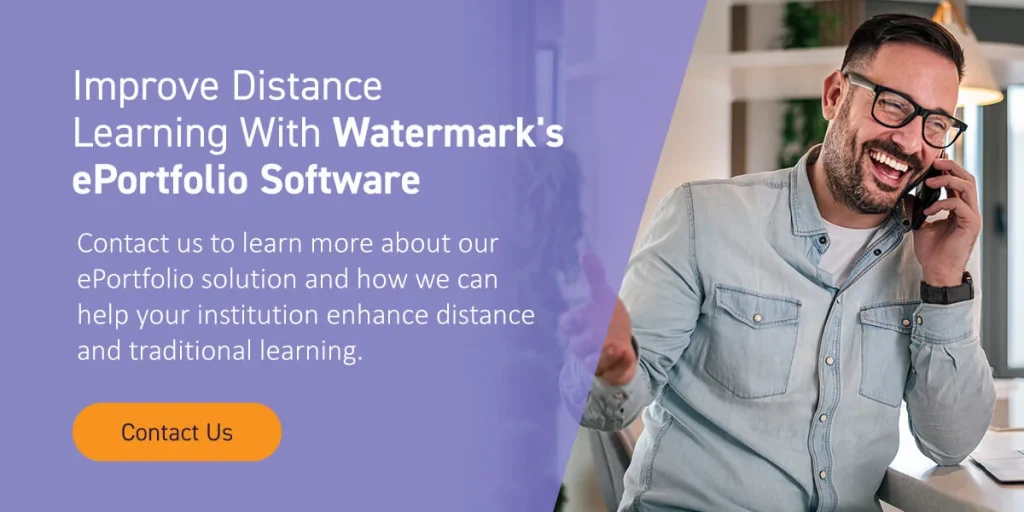




Using ePortfolios is recognized as a high-impact practice by thought leaders such as the Association of American Colleges & Universities (AAC&U). Though we often think of them supplementing in-person instruction, ePortfolios provide important opportunities to ensure that the distance learning experience is as rich and powerful as what students can get sitting in a classroom.
Understanding how ePortfolios aid with remote learning can help your institution improve online courses and distance learner experiences. Consider the following 10 ways ePortfolios support distance learning:
For faculty, an ePortfolio solution provides the opportunity to design interactive activities aligned with critical general education competencies and learning outcomes. Using templated tools, faculty can customize assignments to support embedded video, literature analysis, and more. In addition, faculty can easily monitor student progress to provide targeted support and adjust teaching practices in real time, supporting formative assessment best practices.
Finally, faculty can assess gen ed competencies and learning outcomes with rubrics while assigning scores to send back to the LMS grade book, eliminating any duplicate work between assessment and grading. ePortfolios are intuitive and engaging for students to use. They can document a variety of learning experiences, including course, internships, field placements, and cocurricular activities in a central location.
Capturing a body of work in an ePortfolio helps students identify key strengths, weaknesses, and opportunities for improvement. Students also love the “social media experience” of being able to share photos, videos, and audio files in ePortfolios.
Well-designed ePortfolios are responsive, which means that faculty and students can upload, download, and stream content on any device. That’s particularly useful for distance learning, where students and instructors must share artifacts electronically.
In addition, an ePortfolio solution that integrates with your LMS makes it easy for students and faculty to navigate between systems and access activities and learning artifacts across systems. ePortfolios allow students to easily pull artifacts from the LMS into their timelines and showcase portfolios so that they can effectively represent their full body of work.
Best-in-class ePortfolios allow robust rubrics, which serve as a valuable teaching tool for faculty to communicate clear expectations to students. They also include features that make it easy for faculty to provide real-time feedback to students submitting coursework, including features like in-text annotation. An ePortfolio solution enables faculty to align rubrics to standards and competencies, easily use the rubrics to assess student work, and provide clear guidance to students on areas for improvement.
ePortfolios can help students reflect on and engage with their learning throughout their degree program years and between different institutions. They work effectively for diverse learning styles, and they enable individuals to set and reach personal educational goals.
ePortfolios help students develop a sense of personal ownership over their learning and provide a comprehensive record of achievements they can take with them after graduation. That sense of ownership can be particularly important to distance learners, who may not experience the full range of social supports that come with on-campus learning.
The best ePortfolio solutions provide both faculty and students with powerful tools to track their learning over time. They ensure students develop their professional voice and skills to communicate their knowledge and accomplishments to peers and potential employers.
Because an ePortfolio captures a comprehensive view of student work, AAC&U considers it “an ideal format for collecting evidence of student learning, especially for those outcomes not amenable or appropriate for standardized measurement.” An ePortfolio solution should ensure that faculty can:

Because ePortfolios capture a comprehensive view of student progress over multiple years, these tools support faculty advisors, mentors, and administrators to better assist students throughout their academic experiences. With ePortfolios, educators can more confidently ensure students have the services they need to reach critical milestones and complete all necessary program requirements. This is especially important for distance learners who might not benefit from as many face-to-face interactions with trusted advisors or from on-campus support services.
Closing the loop — it’s one of the worthiest goals and biggest challenges in higher education. One of the greatest barriers to meaningful learning outcomes assessment is the time required to analyze data, develop action plans for improvement, and implement changes. Fortunately, ePortfolios make this daunting task substantially more achievable.
Because learning artifacts are naturally captured within an authentic teaching and learning system designed to support robust assessment, there’s no additional time needed to digitize student work and manage assessment processes.
By collecting and reporting on ePortfolio data systematically across programs, faculty and administrators can more effectively track student progress toward key outcomes and develop action plans to support targeted improvements. Once those plans are developed, they can immediately translate into changes in instruction delivered through ePortfolios.
With ePortfolio software, your institution can capture real-time data to monitor your improvement and the impact of your efforts. ePortfolios can be a powerful addition to your institution, whether you use them in conjunction with a traditional classroom setting, distance learning, or both. Learn how other campuses use them and how they increase the potential to change a student’s trajectory.
ePortfolios can help students enhance individualized learning, which is essential for success in distance education. Online learning requires students to remain motivated and self-disciplined so they can take charge of their future. Since ePortfolios promote greater self-reflection and progress tracking, they make it easier for students to adjust their learning habits, experiences, opportunities, and career paths.
ePortfolios let students prepare for post-graduation careers, helping them ensure they have the educational background, skills, and knowledge they need to enter the industry they choose. For example, examining an ePortfolio can help a student determine if their current work samples and experiences line up with what employers in their chosen field look for. If there is a gap, the student can request specific courses or seek guidance to gain the skills future employers need.
Creativity is an important soft skill in any industry because it enables a person to develop innovative solutions when challenges arise. An ePortfolio can help a student approach their career path creatively, compiling their work and skills with originality.
Helping distance learners strengthen their creativity can be challenging since remote students work primarily independently, but ePortfolios make it easier to encourage originality and innovative thinking. Educators can review student work and ensure their ePortfolios highlight their creative abilities.
Digital literacy is another important skill as technology becomes more prevalent in all industries. ePortfolios help students increase and maintain their digital skills, preparing them to continue learning as technology advances and expands.
Since ePortfolios display achievements, progress, and work samples, students can use them to increase confidence. An ePortfolio can help reduce the isolation distance learners may feel being outside of a traditional classroom setting, letting them view regular feedback and feel confident in the skills they are building. An ePortfolio enables a student to see the work they produce compiled on one platform, growing their confidence in their abilities.
Evaluating a remote course’s success in educating distance learners can be challenging since the instructor is not in a physical setting with students. By assessing ePortfolios and tracking each student’s progress through their ePortfolio, instructors can identify areas for improvement and adjust their teaching approaches accordingly.
Whether they need to shift the material they focus on or adjust project timelines, instructors can use ePortfolios as a powerful remote course improvement tool.
ePortfolios can significantly enhance distance learning, providing students with a comprehensive self-reflection tool. Students and instructors can benefit from ePortfolios because they enhance skill evaluation efforts and help increase each student’s confidence levels.
Watermark offers an ePortfolio solution to help higher education institutions improve student experiences in remote courses and traditional classroom settings. Watermark Student Learning & Licensure provides a platform to store, organize, track, assess, and provide feedback on student work comprehensively. Contact us to learn more about our ePortfolio solution and how we can help your institution enhance distance and traditional learning.






























































































































































































































































































































































































